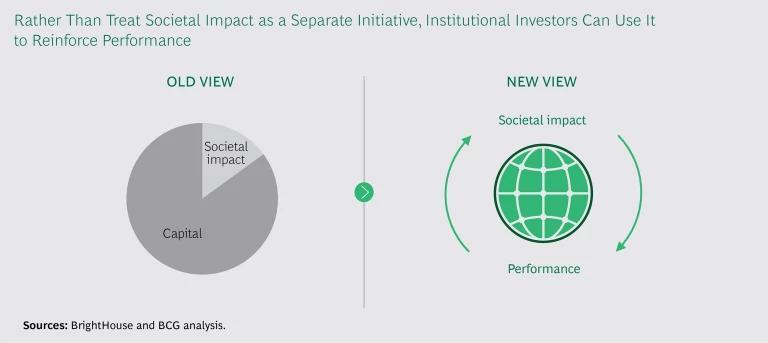Institutional investors are entering a new era in which they seek not only to generate financial returns but also to create greater social good. For example, JANA Partners (a New York investment firm) and a pension fund for California teachers, which together hold about $2 billion in Apple stock, recently asked Apple to take steps to reduce the overuse of its products by children. BlackRock, the world’s largest institutional investor (with about $6 trillion in assets), sent a much broader signal when CEO Larry Fink published a letter encouraging companies to “…not only deliver financial performance, but also show how [the company] makes a positive contribution to society.” The letter continued, “Without a sense of purpose, no company, either public or private, can achieve its full potential.”
We agree. Moreover, we believe that Fink’s message applies to institutional investors themselves, as well. By uncovering and articulating a clear and authentic purpose for their own firms, institutional investors can far more effectively steward investment capital and deploy it—for both financial returns and societal impact. Expressed as a powerful and memorable one-line statement, the purpose can serve as a firm’s North Star, guiding its decisions, including those that involve strategic objectives and investment choices.
A clear and authentic purpose can serve as a firm’s North Star.
Yet while many investment firms have articulated some kind of mission or purpose statement, such declarations are frequently inadequate, reflecting an undifferentiated or functional view of the firm’s role. On the basis of more than 20 years’ experience in helping Fortune 500 organizations articulate their purpose, we believe that firms need to dig deeper and follow a structured approach that taps into their DNA and aspirations for societal impact and brings the purpose to life throughout the organization.
A Convergence of Trends
There is a growing demand for socially responsible investing. Some $23 trillion in assets are currently allocated to such investments, and an increasing number of investors seek products and firms that can deliver both returns and societal benefits. Stakeholders as varied as customers and governments are pushing companies to help solve challenges such as climate change and economic inclusion.
Investors themselves have an increasing desire to understand the risks from these challenges. Recently, for instance, more than 150 financial companies with $82 trillion in assets (collectively) signed on to the recommendations of the Task Force on Climate-Related Financial Disclosures. This focus will only grow, particularly in light of mounting evidence that addressing social issues does not detract from financial performance. As earlier BCG research has shown, the two objectives of total shareholder return (TSR) and total societal impact (TSI) can reinforce each other; companies with greater TSI performance can also have greater financial performance. (See Total Societal Impact: A New Lens for Strategy, BCG report, October 2017.)
What’s more, socially responsible investing makes firms more attractive to prospective employees, giving such firms an edge in the war for talent. In our experience, employees in investment firms are passionate about what they do and are motivated by far more than a singular pursuit of financial returns. They recognize that capital can be used to unleash societal progress and impact. Without a clearly articulated authentic purpose, however, few organizations will capture that underlying excitement and realize the full potential of their societal impact.
The Power of Purpose
Purpose is a central, organizing principle that guides employee actions at all levels of the company and provides an authentic foundation for strategy, culture, investment decisions, and societal impact. Unilever’s purpose-driven brands, for example, are growing 50% faster than the rest of the brands in the company’s portfolio, and they are delivering 60% of the company’s total growth. Additional research by BrightHouse of 25 large, public US companies in the consumer, technology, and financial-services sectors found that the companies with the strongest sense of purpose integrated across their operations showed the highest ten-year TSR.
Institutional investors have a similar opportunity to articulate a purpose that goes beyond financial returns. Rather than deploy a small portion of capital toward societal impact, investors can start by articulating an authentic purpose that manifests the firm’s reason for being and guides investment objectives. In so doing, they can express how those objectives create greater good in the world—two goals that mutually reinforce each other. (See the exhibit.) Purpose informs an institutional investor’s strategy for creating societal impact by providing guidance on where to concentrate resources. This allows the firm to focus on achieving the biggest impact in a sustainable way; over time, a sustained focus on the issue will only reinforce the investor’s purpose.
Through an authentic purpose, investment firms can also capture many other well-documented benefits, including better productivity, employee engagement, innovation, and a more compelling brand story.
Thus far, many institutional investors and pension funds have lagged in unearthing their own distinct purpose. Based on our analysis of a sample of institutional investors, many have defined a mission statement of sorts, but most of those declarations do not represent a true purpose. For example, some have defined their purpose in terms of generating the highest possible returns for the entities whose money they manage—a universally applicable premise for the work that all institutional investors do. (See the sidebar “How the Mission Statements of Big Investors Fall Short.”)
How the Mission Statements of Big Investors Fall Short
How the Mission Statements of Big Investors Fall Short
We recently analyzed the mission statements of several dozen institutional investors. The results show that most firms have a big opportunity for improvement. Here’s where the declarations go wrong:
- They rely on platitudes and generalities. Many institutional investors’ purpose statements use the same language, and few are distinctive or memorable. For example, many firms say that their mission is to serve as stewards of the capital of the investors whose money they manage. That may be true, but it’s true for all firms in the industry, so the statement is neither unique nor differentiated.
- They focus on the “what” rather than the “why.” Simply explaining what an organization does lacks meaning. It is not as emotionally compelling to employees as explaining why the organization does what it does, which helps people link their individual contributions to the ultimate impact of the organization and shows that they are part of something larger.
- They’re superficial. An authentic purpose isn’t something you can develop in a day; rather, it has to be discovered, through a process of self-reflection that requires firms to consider why they exist. It’s hard work, and it takes time, but it results in more than a tagline; it yields principles and beliefs that create emotional engagement and guide behavior.
Developing an Authentic Purpose
The process of developing a purpose requires a more thoughtful approach than many executives expect; it can’t be completed in a one-day brainstorming session with a handful of senior leaders. An authentic purpose is excavated, not created. It is built on a deep understanding of the organization’s distinct strengths. It distills somewhat abstract ideas into a core message that aids executives in plotting strategy and helps lower-level employees make the right decisions with an understanding of how their individual contributions help the organization reach its objectives. Most important, purpose expands how the firm sees its role in the world.
How do you establish a good purpose? Start by taking a deep dive into your organization’s unique strengths, beliefs, and convictions, and then coalesce them into principles that reflect the firm at its best. This process ensures that the firm’s purpose aligns not only with the values and beliefs of its leadership team and employees but also with the values and beliefs of the investors it represents, such as pensioners in a pension fund.
Next, the firm needs to explore the needs of the world that it can uniquely address. Notably, these go beyond market and functional needs to include human and societal exigencies. At the intersection of those two elements—the firm’s identity and the needs of the world—lies the organization’s unique purpose.
Articulating a purpose is only the beginning of the journey. The next step is to activate that purpose throughout the organization—communicating it both internally and externally, and using it to reshape the firm’s culture, strategy, and branding. Ultimately, it should be something that affects the day-to-day work of every employee, from portfolio managers to support staff. (See the sidebar “Critical Questions.”)
Critical Questions
Critical Questions
Not sure if your firm’s purpose is powerfully articulated and thoroughly embedded? Ask yourself the following questions, which arise in four key areas. If you can’t answer yes to them all, you may be leaving value on the table.
- Articulation. Does your firm have a clear and compelling purpose, distilled to a single, emotive, memorable, inspirational, and timeless purpose statement that captures not the “what” but the “why”?
- Inspiration. Do your employees understand this purpose, and does it galvanize them to perform better? If you were to ask 100 employees why their firm exists, would you get a consistent answer?
- Integration. Are your firm’s leaders integrating the purpose in their key decision-making processes? Does it affect the day-to-day behaviors of both leaders and employees?
- Recognition. Is your purpose influencing the way your firm is perceived by stakeholders, both internally and externally?
The shift to responsible investing among institutional investors is commendable, and firms have the opportunity to build on that shift and fully harness the power of purpose. Purpose acts as a firm’s distinctive North Star and expresses its highest ambition. In doing so, purpose helps capture the energy and imagination of employees, change the discussion with stakeholders, and—far more important—truly change the world.













